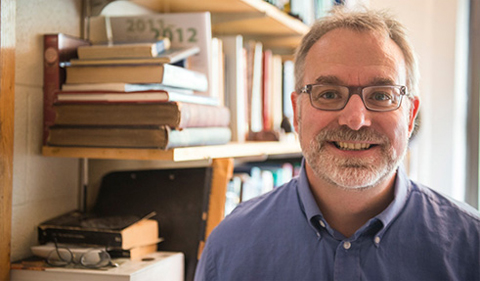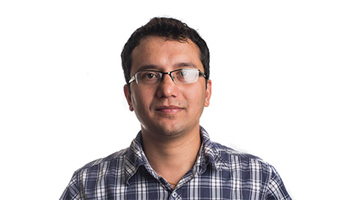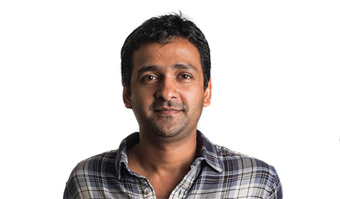Dr. David Drabold, Distinguished Professor of Physics & Astronomy at Ohio University, and Visiting Scholar Parth Biswas co-chaired a symposium on Phase Change and Other Chalcogenide Materials at the May 17-21, 2015, joint meeting of Deutsche Glastechnische Gesellschaf of the German Society of Glass Technology (DGG) and the Glass & Optical Materials Division of the American Ceramic Society (ACerSGOMD.)
This conference is the second of a two-year experiment to combine the American and German annual conferences in an effort to strengthen ties between U.S. and European glass researchers.
Drabold organized the symposium on “Amorphous Semiconductors: Materials and Devices” with Professor Stephen Elliott of the University of Cambridge.
In a session on Amorphous Semiconductors: Electronic Properties, Transport and Modeling, Drabold, Biswaw and two graduate students, Anup Pandey and Kiran Prasai made three presentations.
RMC-Force: Toward a New Strategy for Materials Modeling
Abstract: We introduce a novel structural modeling technique (RMC-Force) which merges the Reverse Monte Carlo (RMC) method and the forces obtained from first principles or empirical potentials. It may be understood as a development of our earlier work “Experimentally Constrained molecular Relaxation” [P. Biswas et al., Phys Rev B 71 054204 (2005)]. The new scheme was used to model amorphous silicon (a-Si), and it produces a model jointly consistent with neutron diffraction data, an empirical potential and existing Wooten-Winer-Weaire models. We note that because a-Si is overconstrained in the sense of Phillips and Thorpe, it is an especially difficult test case. Details of the method and its convergence will be provided. We have extended the method to binary systems, and will also report new models of amorphous silica and other systems. (GOMD-S4-003-2015) RMC-Force: toward a new strategy for materials modeling A. Pandey 1 ; P. Biswas2 ; D. Drabold1 ; 1. Ohio Univeristy, USA; 2. University of Southern Mississippi, USA)
Band Gap Engineering: A Computational Approach
Abstract: The quest for novel materials with special optical, transport or electronic properties is as old as condensed matter physics itself. In this paper, we report a method designed to find atomic coordinates consistent with a desired electronic density of states. To start with, we will give a detailed report on amorphous silicon, and configurations that maximize optical gap and others that maximize metallicity. The primary challenge of the scheme is simultaneously constraining the atomic coordinates to lie in a manifold that minimizes the total energy while satisfying the desired density of states to ensure that the coordinates obtained are realistic (potentially realizable). Preliminary results suggest that new models with improved gaps are close to the traditional minimum energy models with suitable perturbations near the atoms upon which the band-edge states are localized. (GOMD-S4-004-2015) Band gap engineering: a computational approach K. Prasai 1 ; P. Biswas2 ; D. Drabold1 ; 1. Ohio University, USA; 2. University of Southern Mississippi, USA
Physics of a-Si:H Night-Vision Devices
Abstract: For infrared (IR), “night-vision” imaging applications, doped hydrogenated amorphous silicon is of prime interest as the active material placed at the IR focal plane. The physical property that provides this utility is a high temperature coefficient of resistance. In this talk, we discuss the physical origin of this effect, and emphasize the role of the large electron-phonon coupling for states near the band edges. The electrical conductivity is estimated with the Kubo-Greenwood formula and an ab initio Hamiltonian. We also discuss the related problem of acceptor and donor doping with B and P impurities, including all relaxation effects with ab initio interactions. B is shown to enter the network with considerable strain, contributing to the broad valence tail of the material, whereas P is much more “substitutional”. Mobile H is attracted to both B and P, which strongly affects the doping efficiency, and we show that H passivates the doping. Finally, we demonstrate that mobile H and a dynamic lattice induce interesting fluctuations in conductivity that might be associated with the resistivity fluctuations observed in experiments (GOMD-S4-005-2015) Physics of a-Si:H night-vision devices (Invited) D. Drabold 1 ; A. Pandey1 ; 1. Ohio University, USA
Simulations of Silver-Doped Germaniumselenide Glasses and Their Response to Radiation
Prasai also presented a poster, co-authored by Drabold, on Simulations of silver-doped germaniumselenide glasses and their response to radiation.
Abstract: Chalcogenide glasses doped with silver have many applications including their use as a novel radiation sensor. We report the first atomistic simulation of radiation damage and healing in silverdoped Germanium-selenide glass. We jointly employ empirical potentials and ab initio methods to create and characterize new structural models and to show that they are in accord with many experimental observations. Next, we simulate a thermal spike and track the evolution of the radiation damage and its eventual healing by application of a simulated annealing process. The silver network is strongly affected by the rearrangements and its connectivity (and thus contribution to the electrical conductivity) change rapidly in time. The electronic structure of the material after annealing is essentially identical to that of the initial structure. (GOMD-SP-P023-2015) Simulations of silver-doped germaniumselenide glasses and their response to radiation K. Prasai* 1 ; D. Drabold1 ; 1. Ohio University, USA
Electrical Activity of Boron and Phosphorous in Hydrogenated Amorphous Silicon
Pandey also presented a poster on “Electrical Activity of Boron and Phosphorous in Hydrogenated Amorphous Silicon” with Ohio University co-author Drabold.
Abstract: Using realistic models of hydrogenated amorphous silicon and density functional methods, we explore doping and transport with the most popular impurities: boron and phosphorous. We discuss conventional analogies of doping based upon shallow acceptors and donors in a crystalline matrix and highlight the limitations of such an approach. We show that B enters the network always with considerable strain, whereas P is much more “substitutional” in a tetrahedral site. We show that H is attracted to strained centers, especially for B, which increases the likelihood of H passivation effects on B impurities. We elucidate doping and nondoping static configurations in doped a-SiH, and the role of H passivation as a partial explanation for the well-known low doping efficiency the material exhibits. We show that thermal fluctuations (that induce both network motion and H hopping) can also significantly impact conduction. We draw comparisons to experimental work. (GOMD-S4-P027-2015) Electrical Activity of Boron and Phosphorous in Hydrogenated Amorphous Silicon A. Pandey* 1 ; B. Cai2 ; D. Drabold1 ; 1. Ohio Univeristy, USA; 2. Washington University School of Medicine, USA






















Comments